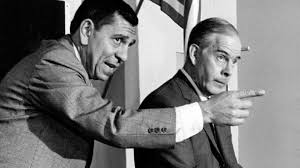If you search the streaming services, you can find a classic 1950’s Police TV Series entitled “Dragnet.” It was a big show in the 1950s, the leading protagonist was Sergeant Joe Friday, played by Jack Webb. Sergeant Joe Friday was a very straight laced detective famous for his investigative technique. In virtually every episode, he drove witness recollections with the phrase, “Just the fact, Ma’am.”
Sergeant Friday wasn’t interested in any of the peripheral issues in investigating crimes. He didn’t care about how people felt, what they experienced. He just wanted the information and data, devoid of everything else. Yet in every exchange there was a huge amount of emotion surrounding the recitation of facts. Victims of crimes were hurt, felt violated, angry that this had happened to them. Witnesses were concerned and worried about what had happened, possibly worried something might happen to them. And the “perps” denied, felt attacked, and angry.
Sergeant Friday seemed ignorant of these emotions, fortunately, his partner, Officer Bill Gannon (Harry Morgan), was very sensitive to these. In each episode, we learned it was the combination of these complementary capabilities was critical to solving the crimes they pursued. Sergeant Friday’s “Just the Facts,” approach limited his ability to connect with victims, witnesses, perps and others. As a result, he often was unable to get the facts. And Bill Gannon, sometimes got diverted, worried about the people.
Today, our engagement strategies, often resemble the techniques of Sergeant Joe Friday. We rush them through the process, focusing on what capabilities they are looking for. We want to understand needs, requirements. “Do they need this capability? What if they had this feature? If they could use this function? Which things are most important to you….”
But we miss the softer side of things, the things that can’t be expressed in terms of capabilities, needs, requirements, features, and functions. We miss the fears and concerns they might have, the worries about “messing up,” their ambitions. We miss that people don’t just buy based on logic, but about how they feel about what they are doing, how they feel about our engagement process.
They care about, “Does the seller understand us and what it means to us? Do they understand the challenges of aligning different interests, priorities, and concerns? Do they understand the challenges they will face in implementation and introducing changes to the organization?” We miss the cues, we don’t tend to take the time to ask about them and understand them.
Complex B2B buying is, well, complex. Each deal is characterized by groups of people doing something they seldom to, they may not understand, and which will impact them personally and organizationally. The most difficult part of their decision is not selecting a solution–probably any that make their short list will work. It’s about all the “stuff” that surrounds this.
What sets great sellers apart from others, is they recognize a buying decision is never about, “Just the facts.” They recognize all the stuff surrounding the process is probably most critical. They focus on the challenges of reaching and maintaining consensus, the fear of messing up (FOMU), the fear of missing out (FOMO), they focus on building the buying team’s confidence in their decision.
Today, 60% of buying journeys fail, primarily because we focus on just the facts, and not what really concerns buyers.
For those 40% that do make decisions, there is a high “regret factor,” around whether they’ve done the right thing (not the right choice).
There is so much opportunity, if we just shift our focus, aligning it with our customers.

Leave a Reply